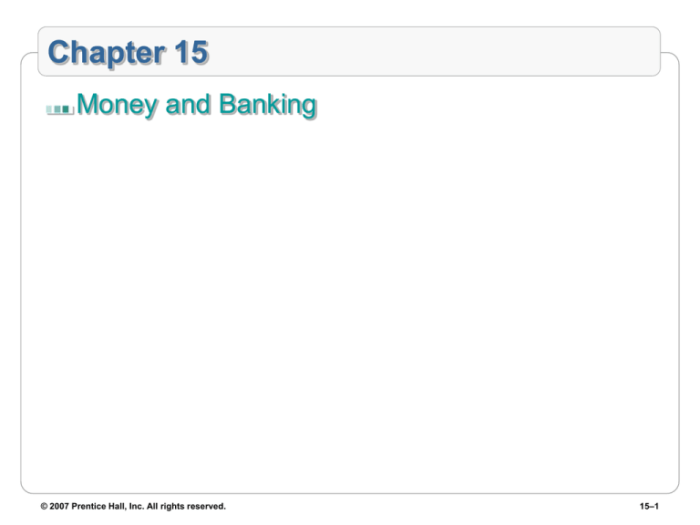Chapter 6 Money in Review delves into the intricacies of personal finance, providing a comprehensive guide to managing money wisely. It emphasizes the importance of financial literacy, budgeting, and debt management, empowering readers to make informed financial decisions.
Through practical tips and real-world examples, this chapter equips individuals with the knowledge and skills to navigate the financial landscape, protect their assets, and achieve their financial goals.
Financial Literacy

Financial literacy empowers individuals with the knowledge and skills to manage their finances effectively. It enables them to make informed decisions about spending, saving, investing, and borrowing. By understanding financial concepts and principles, individuals can achieve financial well-being and secure their financial future.
Financial literacy benefits individuals by enhancing their financial decision-making, reducing debt, increasing savings, and building wealth. It also promotes financial independence and reduces the likelihood of financial distress. For society, financial literacy contributes to economic growth, stability, and reduced financial inequality.
Examples of Financially Literate Behaviors
- Creating and adhering to a budget
- Tracking expenses and income
- Understanding credit scores and managing debt responsibly
- Saving for emergencies and retirement
- Investing in a diversified portfolio
Budgeting and Savings

Budgeting and savings are essential aspects of financial planning that enable individuals to manage their finances effectively and achieve their financial goals. Budgeting involves creating a plan that allocates income to various expenses and savings, while savings refers to setting aside a portion of income for future needs or unexpected events.
Budgeting
Budgeting is the process of creating a plan that Artikels how income will be allocated to different categories of expenses and savings. It provides a framework for managing finances and ensuring that expenses do not exceed income. There are various methods of budgeting, each with its own advantages and disadvantages.
- 50/30/20 Rule:This rule allocates 50% of income to essential expenses (e.g., housing, food, transportation), 30% to discretionary expenses (e.g., entertainment, dining out), and 20% to savings and debt repayment.
- Zero-Based Budgeting:This method requires individuals to allocate every dollar of income to specific categories, ensuring that all income is accounted for and there is no surplus.
Tips for Creating a Realistic and Effective Budget
To create a realistic and effective budget, individuals should consider the following tips:
- Track expenses:Keep track of all expenses, both large and small, to identify areas where spending can be reduced.
- Set realistic goals:Avoid setting unrealistic savings goals that may lead to discouragement. Start with small, achievable goals and gradually increase savings as income and financial situation improve.
- Be flexible:Life circumstances can change, so it is important to review and adjust the budget regularly to ensure it remains aligned with financial goals.
Importance of Savings
Saving is an essential part of financial planning as it provides a financial cushion for unexpected events and allows individuals to achieve long-term financial goals. There are two main types of savings: emergency funds and long-term savings.
- Emergency Funds:Emergency funds are intended to cover unexpected expenses, such as medical bills, car repairs, or job loss. Experts recommend saving enough to cover three to six months’ worth of living expenses.
- Long-Term Savings:Long-term savings are intended for future goals, such as retirement, education, or a down payment on a house. These savings are typically invested in vehicles that offer potential for growth, such as stocks or mutual funds.
Credit and Debt Management

In today’s financial landscape, credit plays a significant role. It enables individuals to access funds for various purposes, such as purchasing a home, financing a car, or consolidating debt. However, it’s crucial to understand the concept of credit and its implications to make informed financial decisions.
Types of Credit
There are several types of credit available, each with its own terms and conditions:
- Credit Cards:Flexible and convenient, credit cards allow you to make purchases and pay them off later. They typically come with varying interest rates and fees, so it’s essential to compare options before choosing one.
- Loans:Loans are borrowed funds that are repaid over a fixed period, with interest. Common types include personal loans, auto loans, and mortgages. The interest rate and loan term will depend on your creditworthiness and the lender’s policies.
- Lines of Credit:Similar to credit cards, lines of credit provide access to a revolving balance that can be drawn upon as needed. They often have lower interest rates than credit cards but may require collateral.
Responsible Credit Use
Using credit responsibly is key to avoiding excessive debt. Here are some tips:
- Track your expenses:Keep a close eye on your spending to ensure you’re not overextending yourself.
- Pay your bills on time:Late payments can damage your credit score and lead to additional fees.
- Keep your credit utilization low:Using only a small portion of your available credit demonstrates responsible borrowing.
- Avoid unnecessary credit inquiries:Multiple credit inquiries in a short period can lower your credit score.
Debt Management, Chapter 6 money in review
If you find yourself struggling with debt, there are strategies available to help you manage it effectively:
- Debt Consolidation:Combine multiple debts into a single loan with a lower interest rate, making repayment easier.
- Debt Counseling:Seek professional guidance from a non-profit credit counseling agency to develop a personalized debt management plan.
- Debt Settlement:Negotiate with creditors to pay less than the full amount owed, but this can damage your credit score.
Investing and Wealth Building

Investing is the act of allocating money with the goal of generating income or profit. It involves putting your money into various financial instruments like stocks, bonds, and mutual funds, which have the potential to grow in value over time.
By investing, you can harness the power of compounding returns, where your earnings are reinvested to generate even more earnings, leading to significant wealth creation in the long run.
Understanding Investment Options
There are various investment options available, each with its own risk-return profile:
-
-*Stocks
Represent ownership in a company and have the potential for high returns but also carry higher risk.
-*Bonds
Loans made to companies or governments, offering fixed interest payments and lower risk compared to stocks.
-*Mutual Funds
Chapter 6: Money in Review is a fascinating read. It covers everything you need to know about managing your finances. But if you need a break from the serious stuff, check out this fun little word game: t h r o a t unscramble . It’s a great way to test your vocabulary and have some fun at the same time.
Then, come back to Chapter 6: Money in Review to finish up your financial education.
Diversified portfolios of stocks, bonds, or other assets, managed by professional fund managers, providing a balance of risk and return.
Developing an Investment Strategy
Creating an investment strategy is crucial for maximizing returns while managing risk. Consider the following factors:
-
-*Goals
Define your financial goals, whether it’s retirement, buying a house, or education expenses.
-*Risk Tolerance
Assess your ability to withstand market fluctuations and determine the level of risk you’re comfortable with.
-*Time Horizon
Consider the period over which you’ll need the funds to meet your goals.
Managing Investment Portfolios
Once you’ve invested, regular portfolio management is essential to optimize returns:
-
-*Rebalancing
Periodically adjust the allocation of assets in your portfolio to maintain your desired risk-return balance.
-*Dollar-Cost Averaging
Invest a fixed amount of money at regular intervals, regardless of market fluctuations, to reduce the impact of market volatility.
-*Tax Optimization
Utilize tax-advantaged accounts like 401(k)s and IRAs to minimize the impact of taxes on your investment returns.
Retirement Planning: Chapter 6 Money In Review

Retirement planning is crucial for ensuring a financially secure future. It involves estimating expenses, exploring savings options, and creating a plan to accumulate sufficient funds for retirement.
Challenges include estimating future expenses, managing inflation, and navigating market volatility. However, planning early and consistently investing can help overcome these challenges.
Retirement Savings Options
Various retirement savings options are available, each with its own tax implications:
- 401(k) plans:Employer-sponsored plans with tax-deferred contributions and potential employer matching.
- Individual Retirement Accounts (IRAs):Personal accounts with tax-advantaged options, including traditional (tax-deductible contributions, taxed upon withdrawal) and Roth (tax-free withdrawals, no upfront deduction).
- Annuities:Insurance contracts that provide guaranteed income streams during retirement.
Calculating Retirement Expenses
Estimating retirement expenses is crucial for determining the savings goal:
- Consider fixed expenses (e.g., housing, healthcare) and variable expenses (e.g., travel, entertainment).
- Adjust for inflation using calculators or historical data.
- Account for potential lifestyle changes and unexpected expenses.
Creating a Retirement Income Plan
A retirement income plan Artikels how to generate income during retirement:
- Estimate income sources (e.g., pensions, Social Security, investments).
- Consider the timing of withdrawals to minimize taxes and maximize longevity.
- Explore strategies like annuities or reverse mortgages to supplement income.
Maximizing Retirement Savings
Strategies to maximize retirement savings include:
- Start saving early and contribute consistently.
- Take advantage of employer matching contributions.
- Consider increasing contributions over time as income grows.
- Explore catch-up contributions for those over age 50.
- Seek professional advice to optimize savings and investment strategies.
Consumer Rights and Financial Protection

Consumers have certain rights and protections when it comes to financial products and services. These rights are designed to ensure that consumers are treated fairly and that they have access to accurate information about financial products and services.
Government agencies and consumer advocacy groups play an important role in protecting consumers. These organizations provide information about consumer rights, investigate complaints, and advocate for changes to laws and regulations that protect consumers.
Avoiding Financial Scams and Fraud
There are a number of steps consumers can take to avoid financial scams and fraud. These steps include:
- Being aware of common scams and fraud tactics.
- Never giving out personal information over the phone or email.
- Only doing business with reputable companies.
- Reading reviews and checking references before making a purchase.
Resources for Consumers
There are a number of resources available to consumers who need help with financial disputes. These resources include:
- The Consumer Financial Protection Bureau (CFPB)
- The Federal Trade Commission (FTC)
- The Securities and Exchange Commission (SEC)
- Your state’s consumer protection agency
Top FAQs
What is financial literacy?
Financial literacy refers to the ability to understand and manage personal finances effectively, including budgeting, saving, investing, and borrowing.
Why is budgeting important?
Budgeting helps individuals track their income and expenses, allowing them to make informed decisions about how to allocate their resources and achieve their financial goals.
What are the different types of credit?
Common types of credit include credit cards, personal loans, and mortgages. Each type has its own terms and conditions, and it’s important to understand these before using credit.